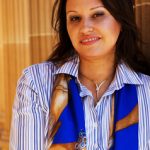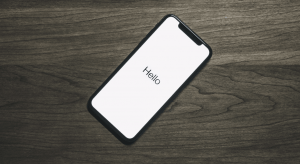Episode Notes
When the Government’s public health warnings came out at the start of the Covid-19 lockdown they were both factual and political, according to Indigenous academic and filmmaker Professor Larissa Behrendt. Why? Find out on this episode of the Seriously Social podcast with journalist Ginger Gorman.
You’ll also discover how indigenous health professionals were well ahead of the game when it came to helping prevent the virus spreading into their communities, and delve into Larissa’s moving new documentary, Maralinga-Jaritza, about the 1950s atomic testing in South Australia.
Watch Larissa’s film on ABC iview
Transcript
Ginger Gorman:
G’day. You are listening to Seriously Social. This is the podcast where we use the lens of the social sciences to help us consider how COVID-19 is impacting Australian society, our relationships, human connections, and societal structures.
We get experts to give us new insights and help us think about things in new ways. With me now is Larissa Behrendt. She’s Distinguished Professor at the University of Technology Sydney’s Jumbunna Institute. Larissa is a Eualeyai and Kamillaroi woman from North-West New South Wales. She’s also a filmmaker and a novelist, and a Fellow of the Academy of the Social Sciences in Australia. Thank you so much for joining me.
Professor Larissa Behrendt :
It’s a pleasure. Thanks for having me.
Ginger Gorman:
Larissa, I’m going to read you a Federal Government warning from health.gov.au, and I want you to tell me what you think of it. This is from the government website.
People aged 70 years and over, people aged 65 years and over with chronic medical conditions, people with compromised immune systems and Aboriginal and Torres Strait Islander people over the age of 50 are at greater risk of more serious illness if they are infected with coronavirus.
What do you make of that warning Larissa?
Professor Larissa Behrendt :
Well, I can tell you what I felt when I first saw it, because as somebody who is on that cusp of 50, it was a bit of a wakeup call to say something so stark, that explains the disproportionate health status of Aboriginal and Torres Strait Islander people compared to the rest of Australia. In that way, it wasn’t surprising because we do know that there is a significant gap there, but I think it is an opportunity to see it in such stark relief that people 50, 50 years over, which sort of is, for many people, does sound quite young to be equated with 70 year-olds, I think starts to give you a bit of a sense of the realities of what that gap means in practice.
Ginger Gorman:
How amazing for someone like me, because I think as a white person, I’ve heard this kind of thing all my life. So I almost didn’t bat an eyelid until you brought it up with me.
Professor Larissa Behrendt :
Yeah. I think it’s been something that has been a bit of, I guess, shines a bit of a light on that issue. At the same time, our community controlled health organisations within the Aboriginal community have been incredibly aware of that and have just been operating knowing that – that’s the reality, that a large amount of that gap means in reality that people have high instances of respiratory disease, heart disease, liver disease. There’s a whole range of things that would be then underlying factors that make people much more susceptible to the impacts of COVID.
Ginger Gorman:
Is this a kind political statement though, in a way, for someone like you, because there’s almost, in that statement, implicit that the rest of Australia doesn’t have the expectation we would close this gap?
Professor Larissa Behrendt :
Look, I think it’s both a political statement and a fact. There’s been a lot of ways in which we’ve tried to lobby around policy approaches that reflect that disparity. One of those has been to have an earlier age pension for Aboriginal and Torres Strait Islander elders as a recognition of that life expectancy difference and the health differences. In a way, it is political, but it’s also the lived reality.
Ginger Gorman:
What’s happening inside indigenous communities at the moment in relation to COVID-19, because you’ve done a lot of work on this, on your Speaking Out programme on Radio National from all different angles?
Professor Larissa Behrendt :
I think if you look at the health warning that you started with as a conversation starter, I think what you can see is that the Aboriginal Community Controlled Health Sector has done a lot of heavy lifting during this time. What making Aboriginal people of 50 equivalent to 70 year olds, in terms of health risk, does is highlight that there are particular complicated health risks that need to be addressed during this crisis. It is primarily the Aboriginal Community Controlled Health Organisations, particularly the Aboriginal Medical Services that are doing a lot of that on the ground work. That work is quite diverse across the country because our communities are diverse. Within our remote communities, there’s been, I think, a very quick and swift response because people understand how vulnerable those communities are in terms of their health needs, and they will not have a lot of health support.
There are some amazing clinics that work remotely. There are Aboriginal health workers and health workers working in those Aboriginal community organisations that do amazing work in terms of those communities with the resources they have, so they were very quick to close off. They were very quick to try and make sure they had medical supplies and food. They have obviously been able to keep Coronavirus out so far. We haven’t seen any communities that have had issues with the virus yet, but people are very diligent about that. What we have seen is concern around food security, which was, I would emphasise, a huge issue before Coronavirus, but as with lots of things within our society, this health crisis has kind of put a magnifying glass on things that were already big issues just waiting to explode. We sort of have seen that come out as an issue.
Then I think, importantly, talking to people who have been leading the Aboriginal community health organisations, talking to indigenous doctors, talking to indigenous health professionals, there is a great concern about Aboriginal people in regional areas and in the urban areas. While there’s been quite a bit of focus on remote areas, quite rightly, a majority of our indigenous populations live in urban areas, the largest indigenous population and one of the poorest lives in Western Sydney. I think, in a way, our Aboriginal Community Controlled Organisations have a greater awareness of what the risks are and where they are, and with no extra money and no extra resources, they’ve really picked up a lot of the heavy lifting.
Ginger Gorman:
You told me a really interesting story about when you were shooting your recent film, Maralinga Tjarutja, which we’ll come back to in a second. You said, very early in the piece, you were in one of those communities, before lockdown, before there was real national public health messaging, what was the Aboriginal nurse there doing?
Professor Larissa Behrendt:
They have a wonderful Aboriginal nurse there, Jason Coombs. We were just filming there on another story, but he immediately called a community meeting to inform people. This was very early on before a lot of other places had started to think about this. He called a community meeting to explain the importance of the sorts of hygiene protections people would have to think about. How to cough properly, washing hands, and those sorts of things that we all had to become a lot more aware of.
The response in that community, a very, very remote community… in fact, Jason told me he believes that it’s the most remote Aboriginal clinic in South Australia, was very early on talking to the community about the fact that there was indications at the time that there was a health crisis coming. He was well aware that as a health professional specialised in this space, that it would have a huge impact if it came into a community like Oak Valley where he was working, and he was taking really proactive measures early on to alert the community and ensure they had important practises in place.
Ginger Gorman:
That’s interesting, isn’t it, that indigenous health practitioners have that reaction? Do you think that’s because they have lived experience of what it’s like for infectious diseases to just rampage through their communities?
Professor Larissa Behrendt :
Yes, it’s true. Even with things like Swine Flu, those infectious diseases that have gone through broader communities have had a disproportionate impact in Aboriginal communities, and that’s a very contemporary health crisis that have caused… It’s a bit of a joke within the Aboriginal community, that we’ve survived smallpox, so we will be able to survive this. I think there is using humour, a kind of reference to the historic context in which Aboriginal people have faced diseases and have been a particularly vulnerable group.
Ginger Gorman:
On a more serious note though, Larissa, I read quite an interesting piece on The Conversation saying that some of the public health messaging was actually quite unfair to indigenous people, because it’s saying stay far apart from other people, wash your hands, get flu vaccines, and so forth, visit health services.
Obviously, these are much harder things for people in very remote communities to achieve. Lots of indigenous people live in big houses with lots of people, for example, it’s not that easy to social distance. Are these the wrong messages or inadequate messages for indigenous communities?
Professor Larissa Behrendt :
It’s also important to point out that the issue around overcrowding is especially problematic in urban communities as well, and that Aboriginal families often live with extended family and multi-generations. It’s quite usual to have overcrowding in Aboriginal communities, both because of the cultural responsibilities to extended family, but also because of poverty. It is actually a universal issue around that.
Look, I think that’s why there needs to be a really strong recognition of the importance of the Community Controlled Aboriginal Health Services, because they have immediately understood where mainstream health messaging is not really appropriate for Aboriginal communities, and the answers being put forward aren’t the right messages for Aboriginal communities. I think they’ve worked a lot more strategically to think about the realities of Aboriginal communities, and then to think about the appropriate health strategies. The Aboriginal Community Controlled Sector has been really proactive in ensuring that Aboriginal people get the flu shot that they need, and are also recommending other shots to be taken to prevent other pneumonia-like viruses from being an issue in the community.
One of the problems for mainstream health messages is, it’s all very well to tell Aboriginal and Torres Islander people to go to a doctor and get these kind of vaccinations, that doesn’t often appreciate the fact that access to doctors is not easy for all Aboriginal people where they live, but more importantly, there is a really historical exclusion of Aboriginal people from mainstream medical services, and continuing, continuing discrimination in the provision of medical services to Aboriginal people within the mainstream health services.
We’ve seen, just through the virus, a couple of examples that have been raised by the Australian Indigenous Doctors Association where health providers in mainstream services have made incredibly racist comments about Aboriginal clients. They are the things that prevent Aboriginal people from attending mainstream health services during a crisis time, and means that they will attend an Aboriginal clinic. They will attend somewhere where there is an Aboriginal nurse. They will attend an Aboriginal medical service. So those services start to play a really important role. I have to say the community has been very proactive in that. I’ve even felt like I’ve had to go and get those shots because of how strong that messaging is. When the aunties tell you to go and get your vaccinations, you don’t argue with them, so off I went.
Ginger Gorman:
One of the other really interesting things that’s happened in the sector is particularly in terms of Aboriginal legal advocates. I know you did a really interesting interview with Cheryl Axleby. She is co-chair of the National Aboriginal and Torres Strait Islander Legal Service. She’s been lobbying in regard to the indigenous community that’s in prison. Could you tell me a bit about what she has told you on your programme, Speaking Out?
Professor Larissa Behrendt :
Yes. Well, Cheryl and the Aboriginal Legal Services have been great advocates during this time, and there have been other great advocates. I think of somebody like Alison Whittaker, because there’s been a lot of Aboriginal lawyers who have also been really proactive in this space with concerns of what might happen if there is a COVID outbreak in a prison, and being very mindful of the over-representation of Aboriginal men, women, and children in correctional centres. There has been a range of strategies in place to try and address this issue, particularly looking at trying to get different remand conditions so that people might be not incarcerated while on remand, but perhaps on bail or some other form to acknowledge that there is a higher risk for infection in institutionalised places.
They’ve also been running important hygiene campaigns. Alison Whitaker, for example, has been on Speaking Out talking about how the Aboriginal community has been just trying to get supplies of soap and hand sanitizer into prisons to help Aboriginal inmates be able to undertake the appropriate hygiene that we’re all able to do, but where there might not be those resources in place. The other things that people are looking at is to look at things for early release or alternatives to sentencing for low risk offenders where that’s appropriate. In a way, what’s interesting about this is, these are all the things that we’ve been saying would be good strategies to reduce over-representation in general.
Ginger Gorman:
Why does it take it a pandemic? That’s what I would like to know. Cheryl was talking about, I think she said 28% of inmates in Australia are indigenous, which is horrifying to start with, but then she was saying this pandemic could actually cause further black deaths in custody. Those two pieces of information together just made me feel nauseous almost.
Professor Larissa Behrendt :
Within the juvenile prison population and the female prison population, there is a much higher percentage of Aboriginal people. That’s why you start to see that there’s a real concern when you think of the increased likelihood of underlying health risks that those inmates will have given the profile of the demographic they come from. There is a real concern that exposure to COVID will lead to an increase in deaths in custody.
Ginger Gorman:
Larissa, I think we could probably stick on this topic all day, but I do want to just move the conversation onto your incredible documentary, Maralinga Tjarutja. I was lucky enough to get an early copy of it, and it’s obviously just screened on the ABC. If you want to watch it, you can catch up on iView. I just cried all through your documentary, pretty much, from start to finish. Could you just briefly tell people who may not have seen it what it’s about?
Professor Larissa Behrendt:
The documentary is the story of the Aboriginal communities that were living on the land where the Maralinga bombing took place, and it tells the story from their perspective. This was a documentary that was really driven by the community. I came in to write and direct the documentary after they had got the ABC to agree to make the film.
They were very, very clear about the story that they wanted to tell. The film actually reflects the story in their terms. Why it’s important to frame it that way is that, although obviously what we know most about Maralinga is the testing, what the community were really wanting to say with their story is that actually the bombing, this devastation of their lands through nuclear testing was just one of three tragedies that befell them as a community. They would say the first was the coming of the railway, that first wave of colonisation that saw the introduction of white men, alcohol, sexual abuse of Aboriginal women, then the removal of half-caste children. That was sort of their first disaster.
The second disaster was the closing of the mission at Ooldea. Ooldea was a very significant site at the edge of the Nullarbor Desert where the water never failed. So no matter how hard and harsh the droughts were over that 60-plus thousand years that Aboriginal people had been living in that area, they could always rely on the water at Ooldea to support life there. It was a very important place also culturally, socially, spiritually. When the railway came, it took 20 years for them to destroy that water source, and so Aboriginal people had to move from that side. That was their second disaster, because the testing was taking place, they couldn’t move back onto their lands up to the north. They were forcibly removed down south to Yalata.
That was part of the story that they wanted to tell, that the testing was one part of the aggressive colonisation that they suffered, but also what was really important as part of their story is that they then fought for 35 years to get their land back, to get the contaminated land cleaned or at least closed off, that authorities who had been responsible for the contamination of that land were held responsible. They have moved back onto that land, they run that land successfully. They have a tourism business at Maralinga. They have a successful art centre at Oak Valley. They have a range of programmes regenerating cultural practise and the responsibility of caring for country. All of those programmes have won awards, and they are a happy, healthy community out at Oak Valley that is culturally strong and has really strong infrastructure; a school, a medical service, arts centre. Really strong community. It is a story that is incredibly heartbreaking and needs to be told to see what some Aboriginal groups have had to really go through in this aggressive kind of colonisation.
I also feel like it’s really a story of resilience and strength, that this is a community that is strong and proud. I’ve worked in communities all around the country. They are probably the most traditional community I’ve ever been in, but they have a very strong school, a very strong medical service, they’ve got solar power. They’ve got a whole range of infrastructure there.
I sort of feel like they’ve given me a new understanding of what Spinifex Country means, because we think of Spinifex Country out there, because the Spinifex is there and it’s this really resilient plant that we’re only just starting to explore its properties, because it’s so strong, so people are kind of putting it in with rubber to make the rubber stronger, and kind of understanding just what a strong plant it is.
Now, I think of Spinifex Country and I think of just how resilient the Spinifex people are. They are like Spinifex. They’re just so resilient, so strong. I think as a filmmaker, what’s really important is that you kind of have to have a real love of your subject matter, and then want other people to see what it is you see in them that makes you love them, and that’s what you need to draw out in a film. That’s what I’ve hopefully done. It shouldn’t just make you cry for the whole time, you should also feel like, “Wow, what amazing people they are.”
Ginger Gorman:
I think though, what was devastating, Larissa, as a white person was just… Gosh, I’m going to cry now, watching these incredibly dignified elders talking about their love for country and their relationships to each other and to their clan in this really broad way, and then just the destruction that white people brought. I kind of just had this feeling in my heart, this can’t be undone, this destruction. I’m not saying they’re not resilient and they haven’t got hope and rebuilt in this powerful way, but it was more the damage that made me cry.
Professor Larissa Behrendt:
Well, I have to say, it was a striking thing for me, because we went up and filmed where the bombs had been set off. I was actually surprised at how much growth there was. I expected that it would just be decimated, and it was surprising to me. I said that to Jeremy who’s one of our lead figures and he’s the chairperson of Maralinga Tjarutja. His whole family have been instrumental in the fight back on all of these issues. He just said to me, “The land will heal itself. We just have to shut it off and let it do its thing.” When they say that, when somebody like Jeremy says that, he doesn’t mean you leave it for 20, 50 years. His view is, we’ve been here since the beginning of time as the people of this country, we will be here for the rest of time on this country. What’s happened here is a blip.
I sort of felt during the time we were filming, a bit before summer, and then we went up during the height of summer and did our last filming towards the end of January, beginning of February. We’d just seen that massive summer of bush fires and all that devastation, and I just thought that’s such an important story for now, just as the story of a 60,000-year-plus water source being killed and ruined in 20 years by misuse by non-indigenous people coming in with no respect and no knowledge.
Also, the experience and wisdom of Aboriginal people about what a resilient country we have was, I think, a really timely message. That’s not to say it’s easy. That means we have to listen to country, we have to give country the time it needs to recover and heal. Sometimes, as Jeremy says, that means leaving it alone. For me, it felt like there was a lot of wisdom in what the people who are now on that Maralinga Tjarutja area know about country and their relationship to it that are really important lessons for the time we’re living in.
Ginger Gorman:
This episode of the podcast is going live in Reconciliation Week, and it seems like a timely moment to say to you, where are we with this? What do we need to do?
Professor Larissa Behrendt :
I think it’s a mixed report card, and it’s a moment to reflect on that. If you think back to a point that you made at the beginning of our conversation about how health messages during COVID-19 have equated 50-year-olds Aboriginal people with being at the same risk as 70-year-old non-indigenous people, there is some stark differences of where Aboriginal and Torres Strait Islander people sit within our society. We’ve also touched on issues around over-representation in the prison system as well during this conversation, and so we could point to a whole range of those factors. We’ve talked about poverty, we’ve talked about overcrowding.
Even in this conversation, we’ve talked to a number of things that continue to be lived experience of a lot of Aboriginal and Torres Strait Islander people, where there still needs to be a lot of improvement. Where I think we can be much more celebratory about what has been achieved, is when we look at the extent to which Aboriginal and Torres Strait Islander people are on the radar of Australians. I think if you look back 20 years ago, nobody started any official event or public event with an acknowledgement, a Welcome to Country.
That’s a small thing in some ways, but it’s a big thing in other ways. It changes us from a country that sort of assumed that Aboriginal people in many places didn’t exist. I grew up in Sydney. I often heard there were no Aboriginal people there, even though was highly involved with the Redfern Community. There was sort of a view that we weren’t real Aborigines. We’ve done a lot to bust those myths, and I think most Australians now know who the Aboriginal people are, who are the traditional owners of the country that they live on, because they engage in those kind of protocols. I think there’s a greater acknowledgement of what Aboriginal culture and storytelling contributes to national conversations.
I really think it’s important too to stress the work of Aboriginal media, of places like NITV, which I think does an enormously important role in being able to give indigenous story, and being able to give Australians who want to know an indigenous perspective, a different angle.
I think that in those ways, we’ve seen a profound change, and of course in curriculum. I think if you look at the role that the Australian Indigenous Doctors Association have played, and I’ve mentioned the enormously important role they’ve played during this health crisis. When I was talking to them on Speaking Out, it was a chance to revisit much deeper changes that they’ve made. Every medical school in the country teaches indigenous content. Every medical school in the country knows the importance of graduating doctors who understand how to deal with indigenous clients. These are quite profound changes that we’ve seen.
I think the emergence of more Aboriginal people, the work of the Aboriginal Community Controlled Organisations has actually meant that there has been quite significant shifts that might seem like small steps, but a big step. I think, for me, they are the things to celebrate during Reconciliation Week. Of course, we’ve got so much further to go, but I think if we look and see what we’ve achieved, not so much to pat ourselves on the back, but to sort of say, “Well, if we can get this far from where we started, taking the next steps should not be intimidating at all. We should know that we can achieve a whole lot more.”
Ginger Gorman:
Larissa, thank you for speaking with me today.
Professor Larissa Behrendt:
It’s a pleasure. Thank you, Ginger.
Ginger Gorman:
Can I just say once again that you should not miss Larissa’s film, Maralinga Tjarutja. You can catch it on ABC iview if you didn’t see it on ABC TV the first time. Thank you also for listening to and downloading Seriously Social. Please rate us wherever you get your podcasts from, and share it with your friends as well. We’ll catch you next time.
Useful Links




